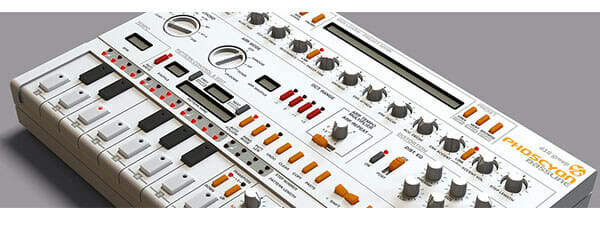

#Phoscyon review plus
This has channels for each layer with level, panning, compressor and three-band EQ, plus three auxiliary busses (reverb, delay and chorus).
#Phoscyon review full
Layers are then hardwired to LuSH-101's master mixer, another full page accessed via the yellow button on the top bar. Below that are MIDI channel assignment, key range and transpose settings. You edit by selecting the layer you want, which precipitates a further preset browser at the top-left that handles multilayer patches. This is handled along the top bar, where you can see eight buttons to enable and mute each layer. However, these aspects simply form what they call a timbre, which is one layer of an eight-layer multitimbral design. I think if they'd left things at that, LuSH-101 would be a pretty solid virtual analogue synth that enhances a classic design. Further options include the arpeggio/gater, which features its own pattern browser, and an insert effect with eight options (phaser, chorus, distortion and so on). This is then enhanced by a unison option (tune, pan and cutoff), although you can't exceed the 32-voice polyphony limit. Portamento is the same as the SH-101, but there's also a mono mode and selectable polyphonic mode (up to 32 voices, with two voice distribution options). In essence this sort of supersizing continues throughout, as you get two full ADSR envelopes, two LFOs (with extra ramp up and down waveforms) and both a high pass filter and a multimode filter (with linear and more unstable SH-101 modes). But most significant is the SuperSaw option, which multiplies up the sawtooth oscillator and adds detune.

D16 also added a choice of noise types (white, pink and brown) and additional sub-oscillator types. I'm not going to list all the differences, but at the most basic level the oscillator section is enhanced to include sync (dubbed HardSync) between the square and saw. So D16 essentially approached the LuSH-101 as a new design inspired by the SH-101. Even so, by today's standards a monophonic, monotimbral design with a single oscillator (albeit with three simultaneous waveforms-sawtooth, pulse/square and sub) looks pretty archaic.
#Phoscyon review portable
It was also portable (and could be battery powered), so along with a guitar strap and its attachable pitch bend and modulation handle, it epitomised the 1980s keytar in all its questionable glory. The layout and slider controls were easy to programme and easy to perform with. The combination of oscillator and filter design could deliver amazingly edgy sounds, great effects and deep bass. The original SH-101 had a number of things going for it. Poland's D16 Group have already impressed with their recreations of three classic Roland drum machines (Drumazon, Nepheton and Nithonat) and the TB-303 (Phoscyon), so the SH-101, in the form of the LuSH-101, was a logical next step for them. There have already been a few SH-101 emulations, including TC's Powercore 01 and TAL's BassLine-101, and both stuck to the monosynth design of the original.

#Phoscyon review software
Thankfully, they haven't been particularly aggressive in preventing other developers from producing software emulations of their famous machines. You'd think it was perfect for soft synth emulation, but Roland have been slow to embrace the format.


 0 kommentar(er)
0 kommentar(er)
